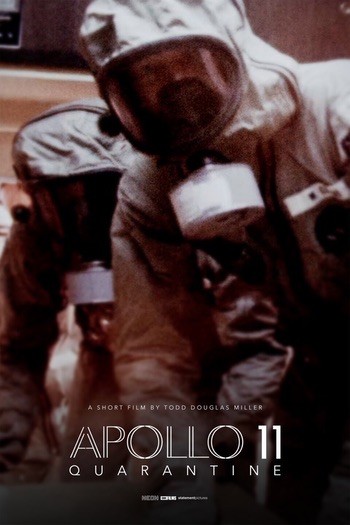Review: Apollo 11: Quarantineby Christopher Cokinos
|
| By foregoing historical and scientific context, the film loses a great deal of potential interest. The imagery, while interesting, hardly ever rises to compelling. |
Because the film is necessarily focused on the human scale—astronauts crawling out of command module in their biological isolation suits, the crew and support personnel gathered in and around the Mobile Quarantine Facility, or MQF (a modified Airstream trailer), the reactions of family as birthday cake is eaten on each side of the glass—Apollo 11: Quarantine lacks the grandeur of the mission overview that was Miller’s Apollo 11. As such, it feels more like a scientific home-movie.
We follow the MQF from aircraft carrier to trucks to cargo planes, finally arriving in Houston, where the astronauts finish out their exile in the larger Lunar Receiving Laboratory—places and procedures put in place to avoid the unlikely event of contamination brought back from the Moon.
The narrator-free documentary has become a standard genre and, here, I think, it does not suffice. The fear of contamination had historical roots at least in part in the study of meteorites, particularly the claim in the early 1960s by George Claus and Bartholomew Nagy that they had found “microfossils” and “fossil algae” forms in meteorites. A scripted documentary could have contextualized NASA’s fears of possible contamination with both geologists’ lack of concern and the long history of imagining life on the Moon. As well, the quarantine procedures and equipment had multiple flaws and leaks, including the mere opening of the hatch at splashdown and how the Navy diver tossed rags used to wipe the capsule into the ocean. NASA’s History office has an excellent page on all this.
By foregoing historical and scientific context, the film loses a great deal of potential interest. The imagery, while interesting, hardly ever rises to compelling. The human-interest angle of the isolation also might have been enhanced by narration regarding the personalities of the crew—reserved Armstrong, didactic Aldrin, playful Collins. Indeed, as Andrew Chaikin notes in his A Man on the Moon, Collins, the commander of Columbia, finished one quarantine debriefing by plaintively saying, “I want out.”
Others may disagree, but the most compelling scenes were, I believe, those of the arrival and unpacking of the lunar samples themselves. Arriving in sealed containers by ordinary car at a loading dock, the Moon rocks steal the show. They are the great unknown here, dark, glittering pieces of our companion world. The careful initial examinations of the samples—using double-gloved waldos inside sealed chambers—prove to be more interesting than the astronauts themselves, whose public images may have saturated our consciousness. As well, the doctors, cooks, drivers, and other non-engineering personnel, who still remain largely hidden in the ongoing Apollo story, deserve their own treatments.
Apollo 11: Quarantine will be passably interesting to the space community, but perhaps not much more. If anything, it whets my appetite for more behind-the-familiar-scenes storytelling, on the page and on the screen.
Note: we are using a new commenting system, which may require you to create a new account.
